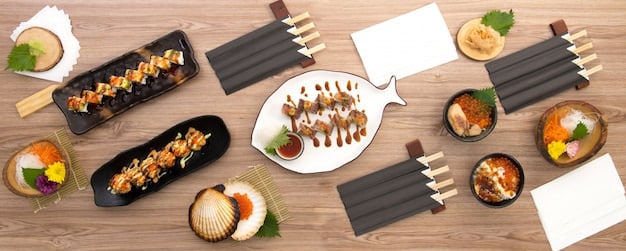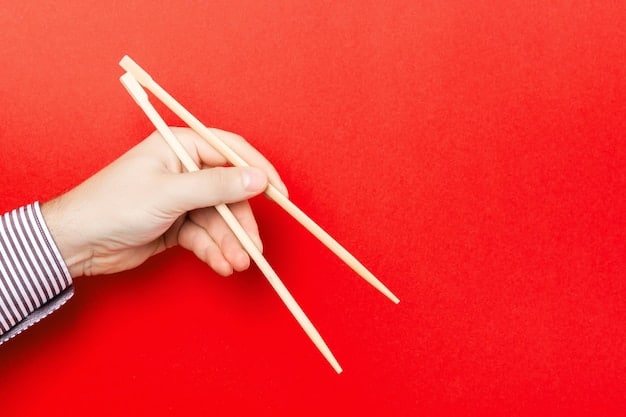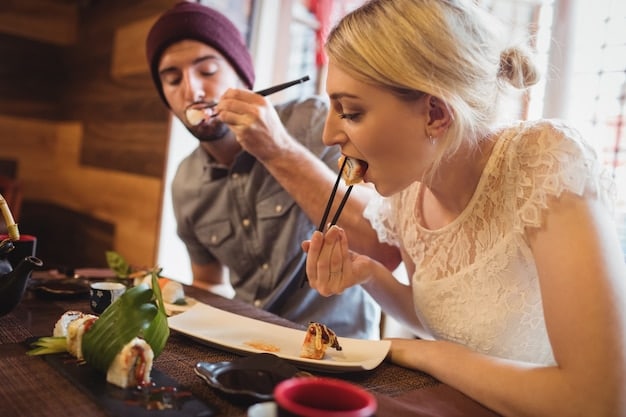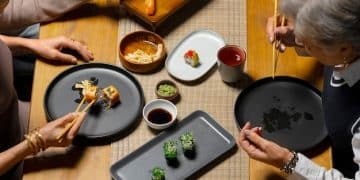Mastering Chopstick Etiquette: A 2025 Guide for US Travelers in Japan

Mastering chopstick etiquette in Japan is crucial for US travelers to show respect and avoid cultural faux pas; understanding proper handling, gestures, and table manners enhances dining experiences and fosters positive interactions in Japanese culture.
Navigating Japanese culture can be exciting, but also a bit daunting. One of the most common, yet potentially tricky, experiences for US travelers is dining, where mastering chopstick etiquette in Japan is essential. Before your 2025 trip, arm yourself with these seven key rules to ensure a respectful and enjoyable culinary adventure.
Understanding the Basics of Chopstick Handling
Before diving into specific rules, let’s cover the fundamental aspects of handling chopsticks. Proper grip and posture are key, not only for functionality but also to convey respect and attentiveness in Japanese dining settings. It’s more than just picking up food; it’s about presenting yourself as a mindful guest.
The Correct Grip: How to Hold Chopsticks Properly
Holding chopsticks correctly involves a specific technique that maximizes control and comfort. The upper chopstick should be held like a pencil, using your thumb, index, and middle fingers for manipulation. The lower chopstick rests in the curve between your thumb and index finger, remaining stationary. Practice makes perfect, so don’t be discouraged if it feels awkward at first.
Posture and Positioning: Setting the Right Tone
Posture at the table is equally important. Sit upright and avoid slouching, demonstrating respect for the meal and your dining companions. When not in use, your chopsticks should rest neatly on a chopstick rest (箸置き, hashioki), if provided. This simple act shows consideration for the dining environment and prevents your chopsticks from touching the table directly.

Here are some key points to remember:
- Grip: Hold the upper chopstick like a pencil for precise movement.
- Rest: Use the chopstick rest when not actively eating.
- Posture: Sit upright to show respect for the meal.
Mastering these basics sets the stage for a smoother and more respectful dining experience in Japan. Remember, it’s not just about eating; it’s about participating in a cultural ritual.
Rule #1: Avoid Sticking Chopsticks Upright in Rice
One of the most critical rules to remember is to never stick your chopsticks upright in a bowl of rice. This action is a significant cultural taboo, deeply associated with funeral rites. It resembles the offering of rice to deceased ancestors, a practice that is considered highly disrespectful in a dining context.
The Funeral Connection: Why It’s a Taboo
In Japanese funerals, a bowl of rice with chopsticks standing upright is placed before the deceased, symbolizing their last meal. Replicating this during a regular meal carries a strong negative connotation, implying death and disrespect towards the host and other diners. Understanding this cultural sensitivity is paramount.
Alternative Resting Positions: Showing Respect
Instead of sticking your chopsticks upright, always use a chopstick rest. If a rest isn’t available, you can lay your chopsticks horizontally across your bowl or on the edge of your plate. These alternatives demonstrate awareness and respect for Japanese customs. Being mindful of these nuances can greatly enhance your dining experience and avoid unintended offense.
Alternatives include:
- Chopstick Rest (Hashioki): Always the preferred option.
- Across the Bowl: Lay them horizontally across your bowl.
- On the Plate: Place them on the edge of your plate.
Avoiding this taboo is a fundamental aspect of mastering chopstick etiquette in Japan. Remember, dining is not just about the food; it’s about showing respect and understanding for the culture.
Rule #2: Don’t Pass Food Chopstick to Chopstick
Another important rule to observe is to avoid passing food directly from one pair of chopsticks to another. This action is reminiscent of a specific part of Japanese funeral rituals, where cremated remains are passed between family members using chopsticks. Replicating this at the dining table is considered highly inappropriate.
The Funeral Rite Parallel: Respecting Traditions
The act of passing bones with chopsticks during a funeral ceremony is deeply symbolic and solemn. Transferring food in the same manner evokes this somber imagery, creating an uncomfortable and disrespectful atmosphere at the dining table. Understanding the origins of this taboo helps to appreciate its significance.
How to Share Food Properly: Acceptable Alternatives
Instead of passing food directly, offer the dish to the person you want to share with, allowing them to serve themselves. Alternatively, you can use your chopsticks to place the food onto their plate. These methods are considered polite and avoid the potentially offensive gesture of passing food chopstick to chopstick. Being aware of these nuances is key to good chopstick etiquette.

Acceptable ways to share food include:
- Offering the Dish: Let others serve themselves.
- Placing Food on Their Plate: Use your chopsticks to transfer food to their plate.
By adhering to this rule, you demonstrate sensitivity to Japanese customs and ensure a more comfortable dining experience for everyone involved. Remember, the goal is to show respect and avoid unintentional offense.
Rule #3: Refrain from Waving or Pointing with Chopsticks
Using chopsticks as a gesturing tool, whether to wave, point, or emphasize a point in conversation, is considered impolite in Japanese culture. Chopsticks are meant for eating, and using them in any other way is seen as distracting and disrespectful to the dining environment.
Avoiding Distractions: The Focus on Dining
Japanese dining emphasizes mindfulness and appreciation for the meal. Waving or pointing with chopsticks disrupts this focus, drawing unnecessary attention and potentially distracting other diners. Maintaining a respectful demeanor is crucial to Japanese etiquette.
Proper Hand Gestures and Alternatives: Keeping It Respectful
When you need to gesture or emphasize a point, put your chopsticks down on the rest or hold them still in your hand. Use your other hand for gesturing, keeping it subtle and respectful. This demonstrates awareness of cultural norms and avoids any unintended offense. Simple gestures maintaining respect will enhance your dining experience.
Alternatives to gesturing with chopsticks:
- Put Them Down: Place chopsticks on the rest during conversation.
- Use Your Hand: Gesture subtly with your free hand.
Being mindful of how you use your chopsticks, even when not actively eating, contributes to a more harmonious and respectful dining experience in Japan. It’s a small detail that can make a big difference in how you’re perceived.
Rule #4: Don’t Spear Your Food with Chopsticks
Spearing your food with chopsticks, instead of picking it up properly, is considered uncouth and displays a lack of chopstick skills. It suggests impatience or a lack of finesse, which is frowned upon in Japanese dining etiquette. The proper use of chopsticks is valued as a sign of respect and cultural awareness.
Demonstrating Skill and Respect: The Art of Picking Up Food
Using chopsticks proficiently is a subtle way of showing respect for Japanese dining traditions. Picking up food delicately and intentionally demonstrates that you value the cultural significance of the meal. Spearing food, on the other hand, is seen as a shortcut that disregards this cultural value.
Techniques for Difficult-to-Grasp Items: Maintaining Elegance
If you’re struggling to pick up a particular item, try using your chopsticks to gently separate it from the rest of the dish, or ask for assistance. There are times when some extra help can prevent the need for unwanted etiquette blunders. Avoid spearing the food at all costs. Maintaining composure while getting assistance is key. These approaches are more respectful and demonstrate a willingness to engage with Japanese dining customs in a considerate manner.
Tips for handling difficult food:
- Separate Gently: Use chopsticks to carefully divide the portion.
- Ask for Help: Request assistance if needed.
By striving to use your chopsticks properly, even when faced with challenging foods, you show a commitment to mastering chopstick etiquette in Japan. It’s a small effort that reflects a deeper appreciation for the culture.
Rule #5: Avoid Licking or Biting Chopsticks
Licking the tips of your chopsticks or biting on them is considered unhygienic and impolite in Japanese dining settings. It’s seen as unsanitary and can be off-putting to other diners. Maintaining cleanliness and decorum is essential to proper etiquette.
Hygiene and Consideration: Respecting Others
Japanese dining places a strong emphasis on cleanliness and consideration for others. Licking or biting chopsticks breaks these principles, suggesting a lack of awareness or concern for the well-being of your dining companions. These actions may inadvertently cause offense or discomfort.
Mindful Eating Habits: Maintaining Decorum
Focus on eating your food directly from your chopsticks without unnecessary contact between the utensils and your mouth. If you need to clean your chopsticks, use a provided napkin or ask for a fresh pair. This demonstrates awareness of proper hygiene and respect for dining etiquette. Hygiene is a sign of respect in this culture.
Tips for hygienic chopstick use:
- Eat Directly: Avoid unnecessary contact with your mouth.
- Use a Napkin: Clean chopsticks with a provided napkin.
By minding your eating habits and avoiding these unhygienic actions, you contribute to a more pleasant dining experience for everyone involved. Small details about hygiene help contribute to the overall respect of Japanese meals.
Rule #6: Don’t Hover Chopsticks Over Dishes
Hovering your chopsticks over multiple dishes, indecisively choosing what to eat next, is called “迷い箸” (mayoibashi), or “hesitating chopsticks,” and is considered rude. It suggests a lack of consideration for the meal and can be seen as indecisive or greedy. The emphasis should be on making a clear choice and proceeding respectfully.
Decisiveness and Respect: Showing Appreciation
Quickly selecting a dish shows appreciation for the meal and the effort put into preparing it. Indecisiveness may make it appear as though you are unhappy or unsure about the food. Japanese culture will always emphasize mindfulness and respect for food choices.
Mindful Selection: How to Choose Politely
Take a moment to survey all the dishes, then make a decisive choice and pick up the desired item. Avoid lingering or hovering your chopsticks over the food. Once you’ve taken something from a dish, move on and allow others to enjoy it as well. Make thoughtful, respectful decisions.
Tips for polite food selection:
- Survey First: Scan all dishes before making a choice.
- Choose Decisively: Pick up the desired item without hesitation.
Practicing mindful selection and avoiding hesitant behavior is key to respectful dining in Japan. It’s a small gesture that contributes to a more harmonious mealtime environment. Be thankful and decisive.
Rule #7: Be Mindful of Communal Dishes
When sharing communal dishes, it’s important to use the serving chopsticks (取り箸, toribashi), if provided, to transfer food to your plate. Using your personal chopsticks is considered unsanitary, as it introduces your saliva into the shared dish. Always be mindful of the hygiene and considerations for others dining with you.
Hygiene and Consideration: Protecting the Shared Meal
Maintaining the cleanliness of communal dishes is paramount in Japanese dining culture. Using serving chopsticks ensures that everyone can enjoy the food without the risk of contamination. This practice shows respect for your fellow diners and a commitment to hygiene.
Using Serving Utensils Properly: Protecting Others
Always check if serving chopsticks are available, and use them to transfer food from the communal dish to your plate. If serving chopsticks are not provided, ask for them or offer to use the back (opposite) end of your chopsticks to serve yourself. Practicing these tips is key towards maintaining Japanese dinner cleanliness.
Key points for communal dishes:
- Use Serving Chopsticks: Always use provided serving utensils.
- Ask if None: Request serving chopsticks if not available.
By being mindful of communal dishes and using serving utensils properly, you demonstrate consideration for the health and well-being of others. Cleanliness is next to Godliness in Japanese society, and it’s a gesture that is sure to be appreciated.
| Key Point | Brief Description |
|---|---|
| 🍚 No Upright Chopsticks | Avoid sticking chopsticks upright in rice, resembling funeral offerings. |
| 🤝 No Chopstick Passing | Don’t pass food chopstick to chopstick, as it mimics funeral rituals. |
| 🥢 No Waving Chopsticks | Refrain from gesturing or pointing with chopsticks to avoid distraction. |
| 🍽️ Use Serving Chopsticks | When available, use serving chopsticks for communal dishes. |
Frequently Asked Questions (FAQ)
▼
Chopstick etiquette is crucial in Japan because it reflects respect, cultural awareness, and consideration for others. Proper usage honors dining traditions and avoids unintentional offense, promoting a harmonious mealtime experience.
▼
If you’re not skilled with chopsticks, practice beforehand. At the restaurant, don’t hesitate to ask for a fork. Most places are accommodating. Showing an effort to learn is always appreciated, regardless.
▼
Generally, it’s best to use the chopsticks provided. Avoid bringing your own unless you’re certain they are appropriate. Different materials and designs can have specific cultural meanings or suit particular dishes.
▼
If you drop chopsticks, discreetly pick them up and signal for a server. It’s polite to ask for a new pair. Don’t attempt to clean them yourself with a shared napkin, as this can be seen as unsanitary.
▼
To avoid indecisiveness, take a moment to observe all the dishes before picking up your chopsticks. Decide what you want to try, then make your selection, picking up the food confidently. Plan your selection as thoughtfully as possible.
Conclusion
Mastering chopstick etiquette in Japan is an essential part of experiencing the culture respectfully. By following these seven rules, US travelers can navigate dining experiences with confidence and demonstrate their appreciation for Japanese customs. This not only enhances your own experience but also fosters positive interactions with locals, paving the way for a more enriching and memorable trip. Remember to always approach new experiences with openness and respect.





